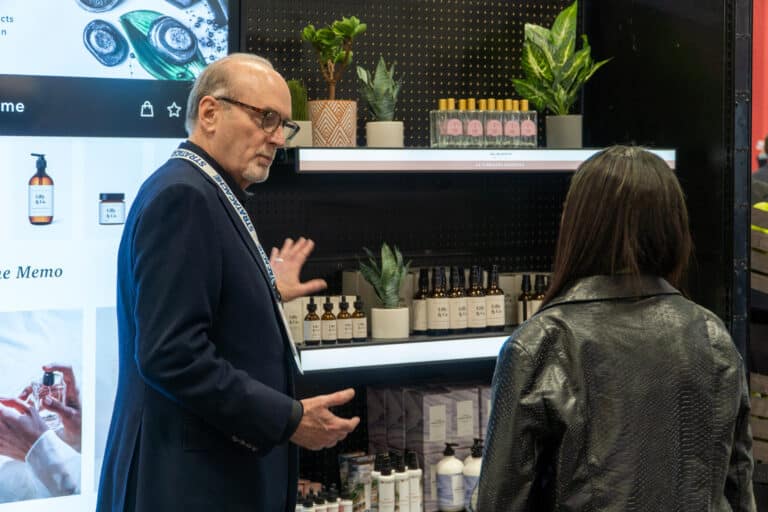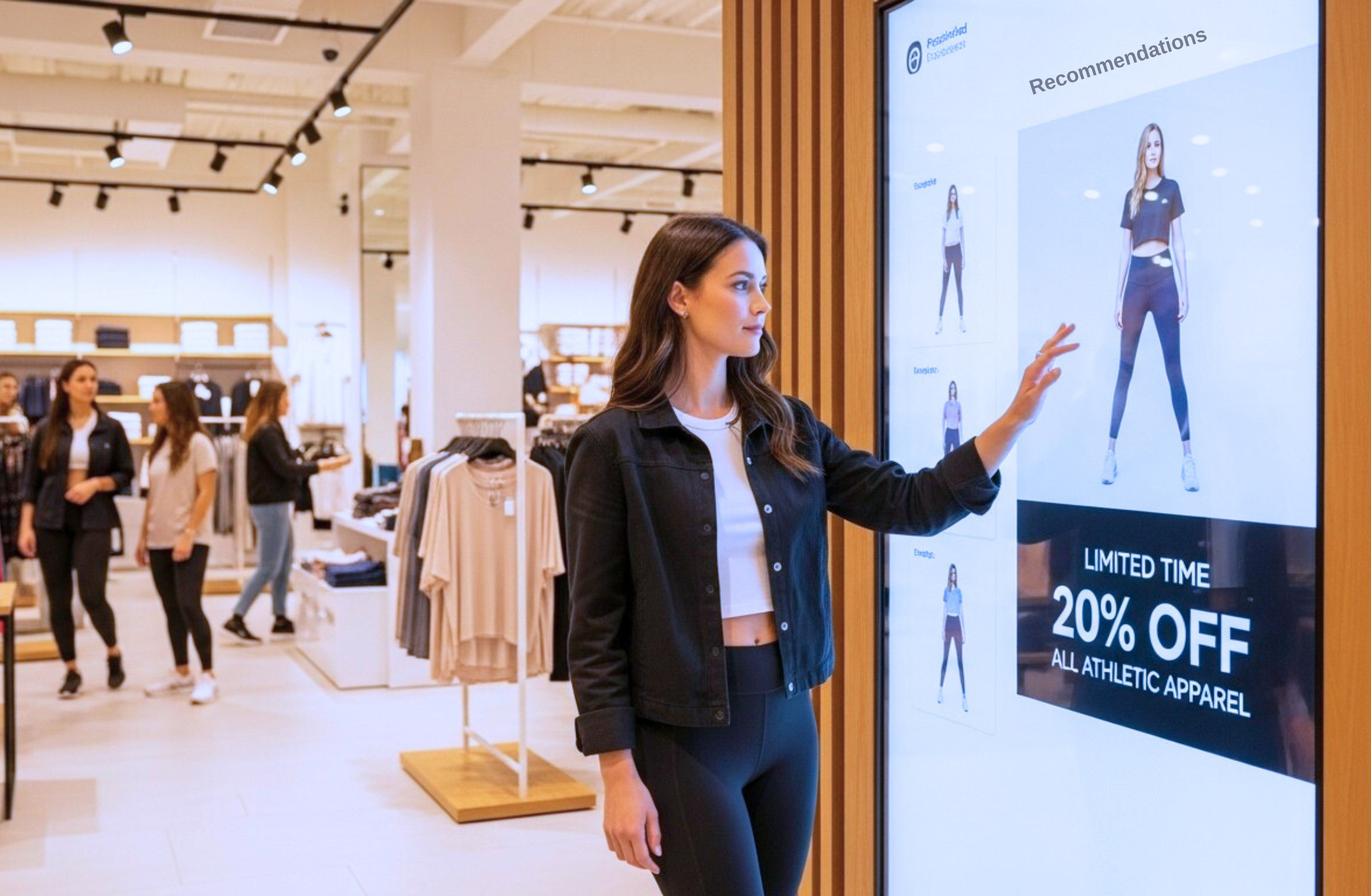
NRF is back in full swing and was busier than ever this year. Let’s hear what the Scala team members had to...

The National Retail Federation’s BIG show, NRF 2023, wrapped up last week after a busy three days filled with hundreds of booths, powerful presentations, innovative technology and thousands of attendees. It was great to be back in New York with the rest of the retail community, demonstrating how our marketing solutions can transform the in-store experience. We talked with our Scala team members to get the inside scoop on NRF 2023. Read on to get their take on hot topics, retail technology and in-store challenges, trends, food tech and more!
Wade Neumeister, Creative Director: Most questions I fielded from retailers were around the digital shelf edge displays. From a tactical/hardware perspective, they wanted to know how easy the units are to install. They were also curious about how the displays are “connected” (for power/data)? From a solution and customer experience perspective, retailers were engaged with the fact that pricing could be kept up to date. Compliance regulations and having to “stop the line” to have an employee go price check were the two biggest challenges they are facing, particularly with rising inflation (changing prices) and staff shortages (we need employees behind the register assisting the line at all costs).
Sarah Dunn, Senior Engagement Strategist: I was pleasantly surprised at the massive turnout for my first NRF conference! The crowds of retailers, service providers, and innovators brought the energy I needed to kick off 2023. It seemed to be the year of transformation. I swear the words “store of the future” could be heard echoing through the building.
Amy Savidge, Senior Director, Enterprise Account Management: There was heavier traffic and we had more conversations having to do with food tech throughout the show and in the booth this year. I’ve headed to New York for NRF nine of the past 10 years, and this is the first time that we had our largest quick service restaurant (QSR) clients attending the event. QSRs want to scale quickly now. They are open to learning from other verticals, like retail, after seeing success with retail technology. These major brands want to have serious discussions about how to bring the restaurant experience current with what retail marketing and innovation teams are accomplishing with technology in stores.
Outside the booth, we had clients giving presentations about how to scale and bring tech into the restaurant. Going beyond fundamental digital menu boards and digital signs, the big topics of discussion are around AI, analytics, personalization and suggestive sell. The number one challenge for QSR and fast casual restaurants is operational efficiency — how to train staff quickly, as turnover is the top-priority challenge they are facing. As a full solution provider with a powerful platform, we can help any retailer or restaurant owner/operator who is facing the challenges and demands of today’s consumer.
Sarah: We had 300+ conversations at our booth, so it was more quick-service discovery vs. our normal process. The Services team was the front-line. Our strategy was to grab attention by telling a story about the experience that explored possibilities beyond the booth and relevant to the brand. The main topics leaned towards our larger Digital Shelf-Edge and Walkbase Analytics displays, which were purposefully bigger and bolder than other experiences in the booth.
Rob Aita, Director of Product Management: As my first time going to NRF, I was blown away by the number of vendors with solutions that can meet every corner of the retail space. It was exciting to see participation from the entire spectrum of company experience – from startups to industry veterans. I was also encouraged by the conversations that we were privileged to have at our own booth. Having an opportunity to see the solutions we have to offer, it’s clear that the experts in retail are passionate about their product and want the best possible way to market that product to the end consumer. I’m looking forward to following up with the introductions that were made and helping them best utilize our product to meet their needs.
Wade: One clear trend retailers we spoke to are facing is staffing. Particularly how do we service customers when employees are simply not available to help them (yet). They seem to know how long their customers will wait before leaving. So will the solution — let’s say the Assisted Selling Kiosk (ASK fixture) — keep them engaged and answer their questions long enough to get an employee to complete the sale? Or how can the ASK itself complete the entire sale cycle, which is something we can achieve with integrations.
Another trend that resonated was the ability to have items delivered. Items that are cumbersome to take home (i.e. big box store bundle products) or items that are not available (i.e. color/size inventory). Having the discussions about tapping into a retailer’s already existing API/website/inventory and using their website as another in-house opportunity to shop, discover and explore deeper into inventory was something that resonated well with retailers.
Chris Roddick, Director, Sales Engineering & Channel Programs: Brick-and-mortar retailers are looking for technology that enables them to compete with ecommerce to create experiences for their shoppers, while using data to target individual shoppers with individualized messaging to increase sales. We were able to illustrate elevating the brand experience while targeting shoppers with product specific recommendations and missed sale opportunities by tracking the shopper throughout the store. Our in-store technology provides the retailer with data on store operations for shopper trafficking and operational details.
Wade: From conversations I was having in the booth, I believe retailers want to prioritize personalization, but the question is how to do it tastefully. How do we offer the same concierge-like service as “an Amazon” without being “creepy.” We can give customers a kiosk or tablet to do self-guided deep dives into product details that matter most to them (star ratings, how-to videos) but how do we predict the content that will resonate with customers and advertise to them before they have to ask or search for it? How do we use sensors and cameras to improve the shopping experience? All roads and conversations led to better integrations with a store’s loyalty app and what products customers check out with. Our in-house sensor-based insights platform, Walkbase, has the ability to tie all of these pieces together in order to form a three dimensional profile of a customer. Then we can tie brand messaging and in-store advertising to a customer’s known interests. They may not know that the laundry detergent ad they are seeing on a display in the aisle is targeted to them, but they will grow to appreciate the recommendations and all of a sudden, the advertisements feel native and helpful.
Sarah: The energy is palpable when a booth visitor discovers an opportunity or solution in the technology. The conversations flip to a stream of substantive questions and brainstorming. For example, when visitors considered our Live Video Chat experience to ease on-site expert shortages or our Walkbase analytics for occupancy, traffic, and queue management solutions.
For retailers considering NRF 2024, know this: There are few opportunities to experience similar and competing technologies and experts at once. When similar technology exists, experience and deliver matter most. Use NRF 2024 to weigh the options and make quick decisions.
Wade: Retailers are taking cues from QSR in the way of order/product customization, speed of service/consistency, and overall experience. Taking a (hungry) customer and instantly, easily, and happily gratifying them is what leads to brand trust. Scala can offer this ability to make the shopping experience helpful, fast, and even fun! Just as store footprints are changing in QSRs, so are they in retail — think of solutions such as self checkout, kiosk ordering, remote customer service. But as long as Walmart is investing $1 trillion in bricks, mortar and asphalt, the best path forward is to help retailers evolve their current footprints to embrace these new experiential ways of shopping that involve digital signage solutions.
Another on-the-nose parallel is in how larger format or big box stores include a restaurant or food service option to customers (Costco, Walmart, Ikea) while they shop, and while not detracting from the shopping experience or time customers have available to shop. They want to offer good food choices that do not require a lot of staff to make or service (rotisserie chickens, subway, meatballs). One way to do this is to make the digital signage do the heavy lifting, from grabbing attention, bringing customers in with value messaging and mouth-watering imagery, to self-service ordering, and digital shelf edge display pickup. Have the staff make the food, keep the location clean, and the digital signage can do the rest.
NRF’s BIG Show gave retailers and innovation teams the opportunity to see the impact that stunning visual merchandising, smart digital signage, data and insights and a wide range of in-store hardware can have on the customer experience. Scala’s full solution includes the software, hardware, professional services and support to bring these digital solutions (and more!) to market at scale.
Next up! We’ll see you at ISE 2023 in Barcelona!


